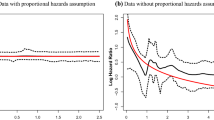Abstract
In a sample of censored survival times, the presence of an immune proportion of individuals who are not subject to death, failure or relapse, may be indicated by a relatively high number of individuals with large censored survival times. In this paper the generalized log-gamma model is modified for the possibility that long-term survivors may be present in the data. The model attempts to separately estimate the effects of covariates on the surviving fraction, that is, the proportion of the population for which the event never occurs. The logistic function is used for the regression model of the surviving fraction. Inference for the model parameters is considered via maximum likelihood. Some influence methods, such as the local influence and total local influence of an individual are derived, analyzed and discussed. Finally, a data set from the medical area is analyzed under the log-gamma generalized mixture model. A residual analysis is performed in order to select an appropriate model.
Similar content being viewed by others
References
Barlow WE, Prentice RL (1988) Residual for relative risk regression. Biometrika 75: 65–74
Benerjee S, Carlin BP (2004) Parametric spatial cure rate models for interval-censored time-to-relapse data. Biometrics 60: 268–275
Berkson J, Gage RP (1952) Survival curve for cancer patients following treatment. J Am Stat Assoc 88: 1412–1418
Cook RD (1986) Assessment of local influence (with discussion). J R Stat Soc 48: 133–169
Díaz-García JA, Galea M, Leiva-Sd́fnchez V (2004) Influence diagnostics for elliptical multivariate linear regression models. Commun Stat Theory Methods 32: 625–641
Doornik J (1996) Ox: an object-oriented matrix programming language. International Thomson Business Press
Escobar LA, Meeker WQ (1992) Assessing influence in regression analysis with censored data. Biometrics 48: 507–528
Farewell VT (1982) The use of mixture models for tha analysis of survival data with long-term survivors. Biometrics 38: 1041–1046
Fleming TR, Harrington DP (1991) Counting process and survival analysis. Wiley, New York
Galea M, Riquelme M, Paula GA (2002) Diagnostics methods in elliptical linear regression models. Braz J Probab Stat 14: 167–184
Goldman AI (1984) Survivorship analysis when cure is a possibility: a Monte Carlo study. Stat Med 3: 153–163
Greenhouse JB, Wolfe RA (1984) A competing riks derivation of a mixture model for the analysis of survival. Commun Stat Theory Methods 13: 3133–3154
Hosmer DW, Lemeshow S (1999) Applied survival analysis. John Wiley and Sons, New York
Ibrahim JG, Chen MH, Sinha D (2001) Bayesian survival analysis. Springer, New York
Lawless JF (2003) Statistical models and methods for lifetime data. Wiley, New York
Lesaffre E, Verbeke G (1998) Local influence in linear mixed models. Biometrics 54: 570–582
Li Y, Tiwari RC, Guha S (2005) Mixture cure survival models with dependent censoring. Harvard University Biostatistics Working Paper Series, vol 41, pp 211–224
Liu SZ (2000) On local influence for elliptical linear models. Statist Pap 26: 1–40
Maller R, Zhou X (1996) Survival analysis with long-term survivors. Wiley, New York
McCullagh P, Nelder JA (1989) Generalized linear models, 2nd edn. Chapman & Hall, London
Ortega EMM (2001) Influence analysis and residual in generalized log-gamma regression models. Doctor thesis, Department of Statistics, University of S⭠Paulo, Brasil (in Portuguese)
Ortega EMM, Bolfarine H, Paula GA (2003) Influence diagnostics in generalized log-gamma regression models. Comput Stat Data Anal 42: 165–186
Ortega EMM, Cancho VG, Bolfarine H (2006) Influence diagnostics in exponentiated-Weibull regression models with censored data. Stat Oper Res Trans 30: 171–192
Ortega EMM, Paula GA, Bolfarine H (2008) Deviance residuals in generalized log-gamma regression models with censored observations. J Stat Comput Simul (to appear)
Paula GA (1993) Assessing local influence in restricted regressions models. Comput Stat Data Anal 16: 63–79
Peng Y, Dear K (2000) A nonparametric mixture model for cure rate estimation. Biometrics 56: 237–243
Peng Y, Dear K, Denham JW (1998) A generalized F mixture model for a cure rate estimation. Stat Med 17: 813–830
Pettitt AN, Bin Daud I (1989) Case-weight measures of influence for proportional hazards regression. Appl Stat 38: 51–67
Sy JP, Taylor MMG (2000) Estimation in a proportional hazards cure model. Biometrics 56: 227–336
Thomas W, Cook RD (1990) Assessing influence on predictions from generalized linear models. Technometrics 32: 59–65
Therneau TM, Grambsch PM, Fleming TR (1990) Martingale-based residuals for survival models. Biometrika 77: 147–160
Author information
Authors and Affiliations
Corresponding author
Additional information
The authors would like to thank the editor and referees for their helpful comments. This work was supported by CNPq, Brazil.
Rights and permissions
About this article
Cite this article
Ortega, E.M.M., Rizzato, F.B. & Demétrio, C.G.B. The generalized log-gamma mixture model with covariates: local influence and residual analysis. Stat Methods Appl 18, 305–331 (2009). https://doi.org/10.1007/s10260-008-0104-x
Published:
Issue Date:
DOI: https://doi.org/10.1007/s10260-008-0104-x




